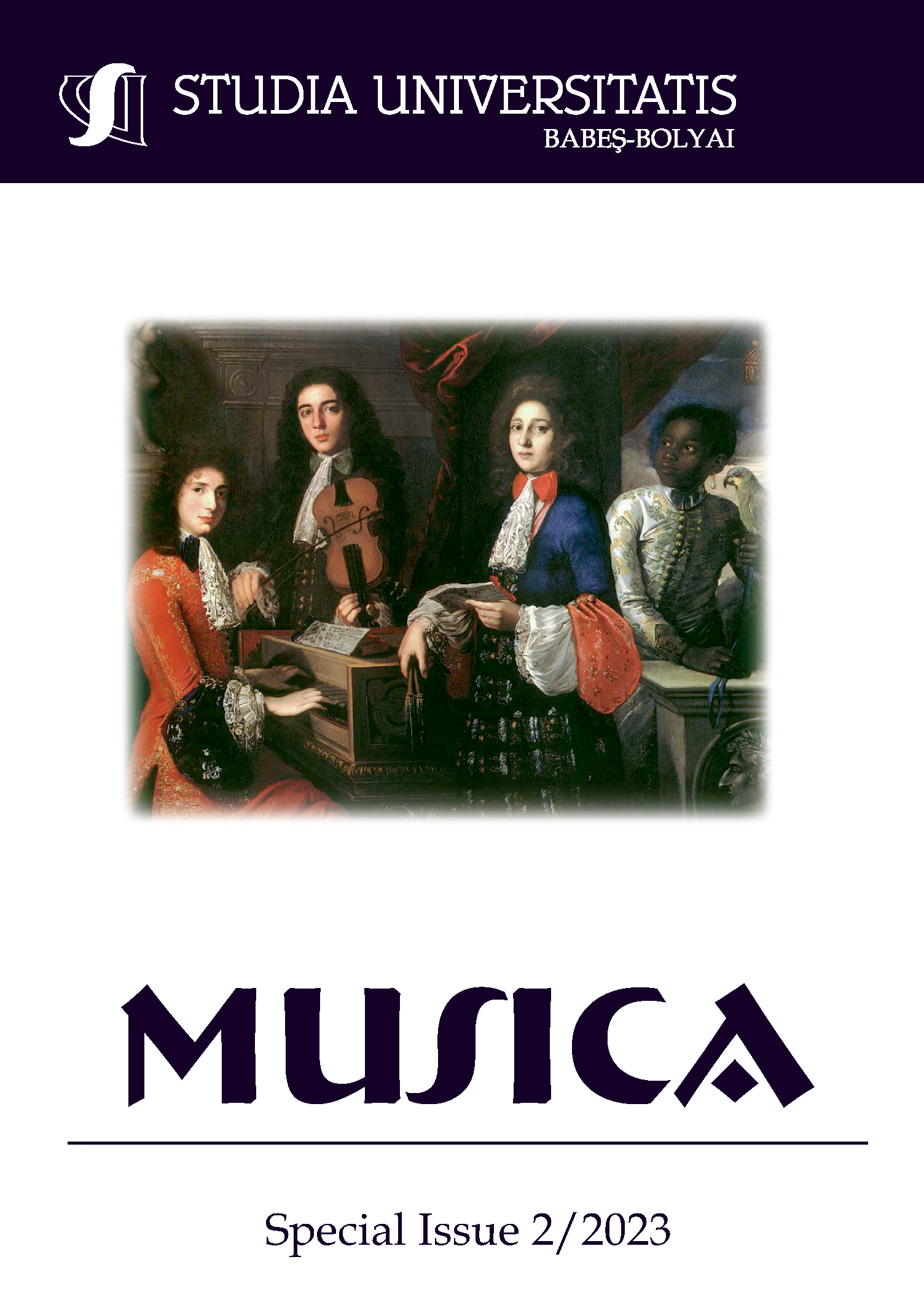ARTISTIC ENERGY OF THE PERFORMERS IN THE MIRROR OF THEIR REPERTOIRE PREFERENCES
DOI:
https://doi.org/10.24193/subbmusica.2023.spiss2.10Keywords:
pianist-performer, artistic energy, piano repertoire, interpretation, performing style.Abstract
The problem field of this article consists of learning the essence of the phenomenon of artistic energy and understanding the performing repertoire as one of the ways of its objectification. Each component of the specified subject of study has its own problem, which is also subject to development. The choice of the proposed subject of scientific cognition is motivated by the desire to understand the phenomenon of the subject of performing interpretative activity. An important factor in its study is the disclosure of the artistic properties of the pianist’s personality, which contributes to the establishment of contact between the concert performer and the listening audience. A little-studied aspect of the analytical consideration of artistic energy remains the question of methods of its objectification, which is the subject of the proposed article. It is stipulated by the perspective of the direction of modern musicology related to the scientific development of the performing repertoire. The location of the selected research subject at the intersection of the named scientific contexts is designed to understand the various properties of the subject of the performing activity as a component of a single system. Therefore, the purpose of this article is to substantiate the idea of the performers’ repertoire preferences as a reflection of their artistic energy.References
Banowetz, Joseph. Guide to the pianist’s repertoire [2th edition]. Piano Quarterly 36, no. 140 [winter 1987-88]: 63.
Deutsch, Diana. Psychology and Music in: M. H. Bornstein (Ed.) Psychology and its Allied Disciplines. Hillsdale: Erlbaum, 1984, pp. 155-194.
Dumm, Robert. Guide to the pianist’s repertoire. Clavier 41 (5) 2005, p.28
Gabrielsson, Alf. The Performance of Music. The Psychology of Music. Cognition and Perception (Second Edition), 1999, pp. 501-602.
Garaz, Oleg. The Origin of the Concept of Style in European Musical Thinking. In STUDIA UBB MUSICA, LXVII, Special Issue 2, 2022 (p. 7 – 19) DOI: 10.24193/subbmusica.2022.spiss2.01
Govorukhina, Nataliya; Smyrnova, Tetiana; Polska, Iryna; Sukhlenko, Iryna; Savelieva, Ganna. Style as a Topical Category of Modern Musicology and Music Education. In STUDIA UBB MUSICA, LXVI, 2, 2021 (p. 49 – 67) DOI: 10.24193/subbmusica.2021.2.04
Gulda, Friedrich. “Zum Vortrag von Beethovens Klavier- Sonaten (For the performance of Beethoven’s piano sonatas). Österreichische Musikzeitschrift, vol. 8, no. 10, 1953, pp. 287-290.
Hinson, Maurice. Guide to the Pianist’s Repertoire. Indiana University Press, 1973, 831 p.
Hinson, Maurice. Guide to the Pianist’s Repertoire, second edition. Indiana University Press, 1987, 856 р.
Hinson, Maurice. Guide to the Pianist’s Repertoire, third edition. Indiana University Press, 2001, 976 р.
Hinson Maurice & Roberts, Wesley. Guide to the Pianist’s Repertoire, Fourth Edition. Indiana University Press Bloomington & Indianapolis, 2014. 2408 р.
Jung, Carl Gustav. Man and his Symbols. New York: Doubleday, 1964.
Kapliyenko-Iliuk, Yuliya. Dynamics of the Level Formation of Style Hierarchy in Musical Art. In STUDIA UBB MUSICA, LXVI, 1, 2021 (p. 109 – 124) DOI: 10.24193/subbmusica.2021.1.08
Kosta, Katerina; Ramirez, Rafael; Bandtlow, Oscar F.; Chew, Elaine. Mapping between dynamic markings and performed loudness: a machine learning approach. Journal of Mathematics and Music 10 (2) SI, 2016, pp. 149-172. DOI 10.1080/17459737.2016.1193237
Kretschmer, Ernst. Körperbau und Charakter. Untersuchungen zum Konstitutionsproblem und zur Lehre von den Temperamenten (Physique and Character. Studies on the problem of constitution and on the theory of temperaments). Berlin. Julius Springer, 1921.
Kyjanovska, Luba. Psychological portrait of the composer as a source of knowledge of his individual style. Ukrainian music: Scientific journal. Lviv, 2014, 3 (13). pp. 52–57.
Leonhard, Karl. Akzentuierte Persönlichkeiten (Accentuated Personalities). Berlin. Verl. Volk und Gesundheit, 1968.
Madsen, Soren Tjagvad & Widmer, Gerhard. Exploring pianis performance styles with evolutionary string matching. International journal on artificial intelligence tools 15 (4) Aug 2006, pp. 495-513.
Manildi, Donald. Guide to the Pianist’s Repertoire, Fourth Edition. Notes 71 (2) 2014, pp.312-324
Martienssen, Kаrl. Die individuelle Klaviertechnik auf der Grundlage des schöpferischen Klangwillens (The individual piano technique based on the creative will to sound). Leipzig: Verlag Breitkopf & Härtel, 1930.
Palmer, Caroline. Music Performance. Annual Review of Psychology. 1997. 48: pp. 115–138.
Rabinovich, David. Artist and style. M: Publishing house “Classic-XXI”, 2008.
Roberto Prosseda. Playing Heart, Soul and Feet. The Wall Street Journal. https://www.robertoprosseda.com//en/writing.php?section=90 accessed on February 4, 2023.
Rogan, Michael. Guide to the pianist’s repertoire. NOTES 58 (4) 2002, pp.851-852. DOI 10.1353/not.2002.0094
Rudenko, Nina. Repertoire as the basis of a student’s mastery. Some issues of its accumulation. Music in the system of art education: relationships and countermeasures: materials of the All-Ukrainian Scientific and Pedagogical Advanced Training in the Field of Art History, Musicology, and Music Pedagogy, Odesa, March 15 - April 23, 2021. Odesa: Helvetica Publishing House, 2021. pp. 217–220. http://music-art-and-culture.com/advanced_training.pdf accessed on August 12, 2023.
Salvesen, Christian. Musik als Bewegung: Die Energietheorie der Musik von Ernst Kurth. Tredition, 1st edition, 2020.
Syryatska, Tetiana. Performer Interpretation in the Aspect of Psychology of Music Performer. Thesis for Academic Degree of Candidate of Musical Art. Kharkiv: Kharkiv I.P. Kotlyarevsky State University of Arts, 2008.
Syriatskyi, Viktor. Mystical research technologies in musicology and their use in modern music education. Music and theater education in Ukraine: historical and methodological aspects. Kharkiv: 1998, pp. 42-46.
Varnava, Ruslana. Psychological portrait of the composer as a source of knowledge of the author’s “image” (on the example of Borys Lyatoshinskyi and Vasyl Barvinskyi): diss. ... candidate of art studies. Lviv, 2017.
Yergiev, Ivan. Performance synergy as the main system-forming element of the artistic universe. Scientific Bulletin of the P. Tchaikovsky National Music Academy of Ukraine. Kyiv, 2013. Vol. 107. pp. 28-40.
Downloads
Published
How to Cite
Issue
Section
License
Copyright (c) 2023 Studia Universitatis Babeș-Bolyai Musica

This work is licensed under a Creative Commons Attribution-NonCommercial-NoDerivatives 4.0 International License.






